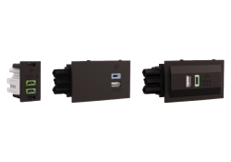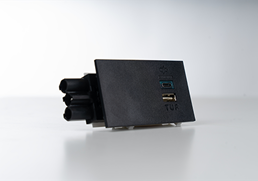Drawing on intelligence from the company’s recent white paper, OE Electrics’ Lee Walker explains how onboard USB charging could streamline and enhance the passenger experience.

Personal electronic devices have transformed the way we communicate, work, and entertain ourselves. So reliant are we on our phones and tablets, that a special term, ‘nomophobia’, has been coined to describe the fear of losing access to them. In 2022, human insights platform Dscout reported that the average smartphone user will click, tap, or swipe their phone 2,617 times a day, while research by LG revealed that 90 per cent of people suffer from ‘low battery anxiety’.
These statistics highlight the extent to which individuals rely on and value their devices. And, to guarantee customer satisfaction, train operators must address their concerns, providing adequate charging facilities on trains. Universal accessibility is key, particularly in the context of commuting and remote work.
Convenient and standardised, USB Type C connectors (like OE’s TUF-R®) offer a solution – and integrating them into train infrastructure could help operators to streamline and enhance the passenger experience.
Train travel: a changing landscape
And it’s not just about low battery anxiety. Today, carriages serve as mobile offices for some busy commuters, who utilise travel time for work or leisure. Indeed, the free time that journeys afford is one of rail’s key selling points – and 2023 research by Transport Focus showed that, increasingly, passengers are using technology to take full advantage of it. Post-COVID hybrid working patterns have contributed to this trend, which will only become more pronounced in future.
Operators strive to create a comfortable and enjoyable environment for customers – and it’s clear that, alongside temperature control, noise reduction, and other amenities, they must provide access to reliable power sources. This is now a necessity rather than a luxury, and key to meeting passengers’ expectations.
Evolving charging solutions
 Passengers would also benefit from a range of charging options, suitable not just for smartphones, but laptops and tablets too. Traditionally, trains have been fitted with AC sockets, accessible to those in window seats. However, many customers dislike travelling with bulky laptop chargers, which are difficult to carry and retrieve from bags. Train designers and operators must take note, providing universal power sources that are compatible with a range of devices, and accessible to all passengers.
Passengers would also benefit from a range of charging options, suitable not just for smartphones, but laptops and tablets too. Traditionally, trains have been fitted with AC sockets, accessible to those in window seats. However, many customers dislike travelling with bulky laptop chargers, which are difficult to carry and retrieve from bags. Train designers and operators must take note, providing universal power sources that are compatible with a range of devices, and accessible to all passengers.
But what are the options? As readers will no doubt be aware, conventional USB-A outlets are polarised, with breakage occurring if plugs are forced in incorrectly. Reversible connectors – like USB-C, the latest and best design available – reduce the likelihood of user damage due to incorrect insertion. A transition from USB-A to USB-C is underway – but, with USB-A chargers still commonplace, OE Electrics ensures that its own USB-A connector is reversible, reducing the risk of damage. The takeaway is clear – when designing the interior of a train, it’s essential to incorporate features like USB charging and suitable connectivity.
“Train designers and operators must take note, providing charging for all devices can only enhance the passenger experience”
USB Type-C: A game-changer
And the advent of USB Type C connectors represents an opportunity to revolutionise charging on trains. As well as enabling passengers to plug in easily, ‘first time, every time’, their higher power capacity means they are suitable for laptop charging.
The fact that most modern laptops feature USB-C ports makes this transition feasible – and in practice, it will enable passengers to replace cumbersome laptop chargers with high-power USB Type C cables. It’s even supported by new legislation; in 2022, the European Commission passed a law stating that all small electronic devices (including Apple products) must have a common charger – USB Type C. This law comes into effect after January 2024 – while, by 2026, all laptops must be USB-C powered.
And, despite rumours that Apple plans to remove charging ports from its phones altogether, wireless charging is unlikely to become the new normal. According to Debugger’s Eric Ravenscraft, charging wirelessly requires 47 per cent more power than cable charging, and takes twice as long. Finally, it’s important to understand passengers’ power requirements. As discussed, charging phones is only part of the story, and many commuters are keen to use their laptops while travelling. With their small form factor and ubiquitous connection, high power USB sockets offer an ideal solution; the power (low voltage DC) they provide is safe, but enough to charge laptops and phones alike.
Ultimately, USB-C is more efficient and environmentally friendly, and making it the default option on trains would promote compatibility, reduce costs, and improve safety. It would also save thousands of tonnes of electrical waste and prevent passengers from charging large devices with the train’s limited supply.
A period of transition
While younger passengers are already accustomed to this kind of USB charging, a transitionary period would give others time to adapt. It’s also important to assure the functionality, data security, and integrity of USB outlets, fostering passenger confidence. But advances in other technologies are already aiding this transition. Many modern devices (including Bluetooth headphones, laptops, and gaming consoles) now charge via USB, meaning the move from AC to USB should be relatively stress-free.
Introducing OE’s Twin USB Charger
 OE Electrics’ Twin USB Charger, TUF-R®, equipped with TUF | PROTECT, addresses the aforementioned challenges. TUF | PROTECT incorporates a system of checks and balances, ensuring the charger operates within predetermined parameters. It exclusively supports power delivery, eliminating data connections or potential privacy breaches. Through device recognition intelligence, the charger also tailors and optimises power delivery, negating potential charging issues. TUF-R® is available in three forms: standard 25W replaceable, high-power 72W replaceable, and 65W non-replaceable.
OE Electrics’ Twin USB Charger, TUF-R®, equipped with TUF | PROTECT, addresses the aforementioned challenges. TUF | PROTECT incorporates a system of checks and balances, ensuring the charger operates within predetermined parameters. It exclusively supports power delivery, eliminating data connections or potential privacy breaches. Through device recognition intelligence, the charger also tailors and optimises power delivery, negating potential charging issues. TUF-R® is available in three forms: standard 25W replaceable, high-power 72W replaceable, and 65W non-replaceable.
Compact and discreet, it can be fitted directly into a train’s seats or tables – or added via one of OE Electrics’ railway approved power modules. It can also be maintained with minimal training, and without an electrician. OE Electrics’ USB-C has been independently tested to withstand 10,000 insertions, while its USB-A charger is reversible, making damage less likely. In the unlikely event that a charger is damaged, it can be repaired in minutes (and without power down) by any member of the service team. Housed in a removable canister, it is easy to replace.
The move towards USB Type C has begun, and soon every device will be designed to accept charging via a USB-C cable. As this transition gathers pace, making clearly accessible USB-C chargers available on trains is imperative for customer satisfaction.
This article originally appeared in Rail director September 2023